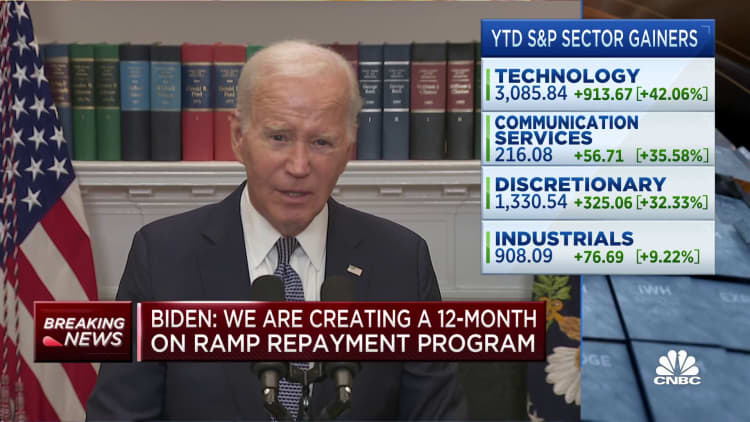After a three-year pause, millions of Americans with federal student loans will receive their first bill in roughly a month.
When borrowers get their bills in October, they'll be interacting with a lending system that has undergone several changes since before the pandemic.
Here are four of the adjustments you can expect.
1. A new servicer, for some
Millions of federal student loan borrowers will have a different servicer when payments resume in October.
That's because several of the lenders that managed the debt for the government — including Navient, the Pennsylvania Higher Education Assistance Agency (also known as FedLoan) and Granite State — stopped doing so during the pandemic-era pause on bills.
Impacted borrowers should get emails about the change, said Scott Buchanan, executive director of the Student Loan Servicing Alliance, a trade group for federal student loan servicers. These notices are supposed to explain any steps you need to take, Buchanan said.
More from Personal Finance:
How to save for retirement when student loan payments restart
It may now be easier to apply for public service loan forgiveness
FAFSA: What's new about the college financial aid application
Higher education expert Mark Kantrowitz has been tracking the transfers.
Borrowers previously with FedLoan should be transferred to MOHELA, or the Missouri Higher Education Loan Authority, he said.
Meanwhile, those who were serviced by Granite State will now be with EdFinancial Services. Accounts with Great Lakes Higher Education should be managed by Nelnet going forward, Kantrowitz said.
And Navient's borrowers will be moved to Maximus Federal Services/Aidvantage.
You can check to see if you have a new servicer at StudentAid.gov, Kantrowitz said.
2. Another repayment option
Federal student loan borrowers can now sign up for the Biden administration's new loan repayment plan, and they could be enrolled in it by the time the bills resume.
The administration estimates that up to 20 million people could benefit from the additional Saving on a Valuable Education, or SAVE, plan, which will cut many borrowers' bills in half.
Some of the benefits of the plan won't fully go into effect until next summer, due to the timeline of regulatory changes. But eventually, instead of paying 10% of their discretionary income a month toward their undergraduate student debt under the previous Revised Pay As You Earn Repayment Plan, or REPAYE, borrowers will pay just 5% of their discretionary income under SAVE.

Even before the drop to 5%, many people will see lower bills. That's because the SAVE plan also increases the income exempted from the payment calculation to 225% of the poverty line, from 150%.
As a result, single borrowers earning less than $32,800 or a family of four making under $67,500 will not owe loan payments anymore if they enroll in the option. If your student loan servicer can't process your application for the SAVE plan by the time payments resume, it should place you in a temporary forbearance.
"The SAVE plan is very generous to borrowers, almost like a grant after the fact," Kantrowitz said.
3. A smoother road to loan forgiveness
The Biden administration has recently taken a number of steps to improve the various loan forgiveness programs offered by the federal government, including income-driven repayment plans and Public Service Loan Forgiveness.
On the income-driven repayment plans, the Education Department will make sure borrowers' previous and ongoing payments are properly calculated so that they get the debt forgiven they're promised after a certain amount of years (usually 20 or 25). Borrowers should also get credit for certain previously ineligible periods, including any months during which they made late payments.
Similar improvements have been made to Public Service Loan Forgiveness, and a recently released tool makes it easier to apply for the debt cancellation after 10 years of payments and employment in an eligible public service job.
In the meantime, President Joe Biden has said he's pursuing another path to deliver broad student loan forgiveness after the Supreme Court blocked his first attempt at doing so in June.
4. Protection from late penalties
For an entire year after student loan payments restart in October, borrowers will be shielded from the worst consequences of missed payments.
For example, loans will not go into default and delinquencies will not be reported to credit reporting agencies, Kantrowitz said. Late fees won't be charged, either.
But as is the case with a forbearance, interest will continue accruing on your debt while you don't make payments. As a result, Kantrowitz recommends borrowers start repaying their bills, if they can.
"Doing otherwise will eventually hurt them," he said.


